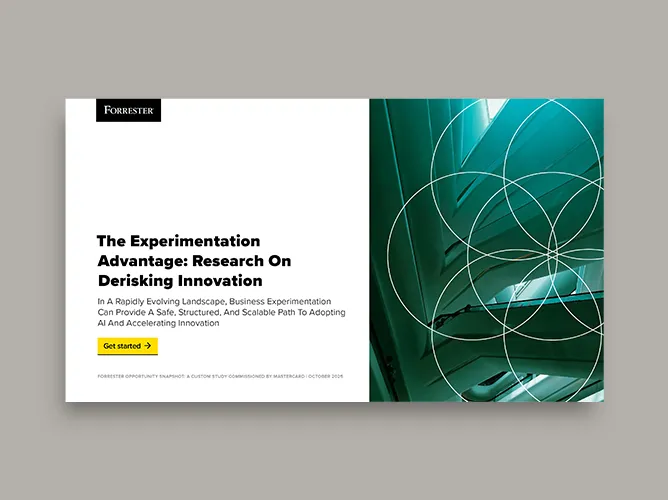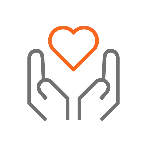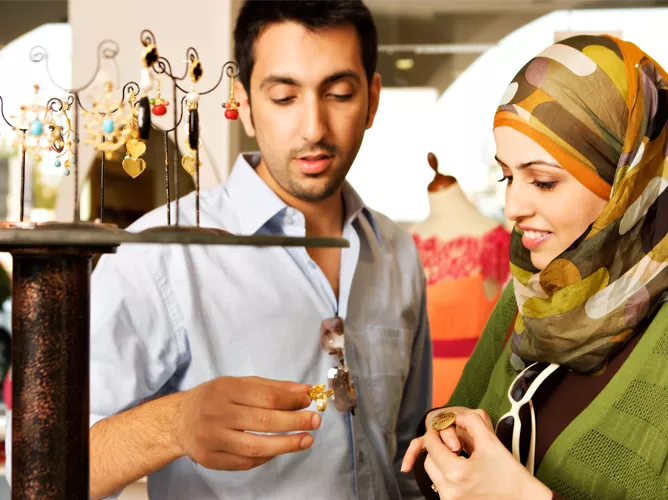By: Lainie Gussman, Katheryn Stanwick and Scott Ruona
Published: June 12, 2024 | Updated: October 29, 2025
Read time: 9 minutes
Loyalty programs – whether punch cards, mobile apps or QR codes – are so ubiquitous that you probably can’t remember the last time you heard someone ask, “How do loyalty cards work?” Today, it takes more than a basic loyalty program to acquire and retain customers.
In this article, we’ll review how to build a successful loyalty program, including:
- What is a customer loyalty program?
- Reasons to create a customer loyalty program
- How to build a customer loyalty program
- Rewards program examples
What is a customer loyalty program?
A customer loyalty program is any tool that helps businesses build a unique customer experience that makes customers want to come back for more.
This loyalty program definition is broad to encompass the different kinds that exist. One well-designed loyalty program could be completely different from another successful program. Customers become loyal to different brands for different reasons. Would you expect your frequent flyer program membership and your favorite restaurant loyalty program to have the same rewards?
Let’s look at different types of loyalty programs, how they work, why they’re beneficial and more.
Types of loyalty programs
Creating the best loyalty program requires identifying the right set of features that customers will appreciate. A successful loyalty program can use a single approach or multiple tactics. The most common loyalty program examples include:
- Points and rewards: A point-based program is the classic example most people are familiar with. Customers earn points in a variety of ways, including points for purchase amounts, activities and bonus awards. Typically, a reward point system allows customers to redeem points for products, cashback or other benefits.
- Member benefits and perks: This type of loyalty program provides exclusive benefits to members. These can be monetary, like everyday discounts, or a customer experience, like event invitations.
- Paid membership or subscription: Some exclusive benefits are worth paying for. Loyal customers may subscribe to a program that provides things like free shipping and/or upgraded services.
- Tiered loyalty programs: A tiered loyalty program combines many of the benefits of a rewards program, a member perks program or even a paid subscription. Each tier provides more exclusive benefits. A point-based tiered program may move customers to higher tiers when they reach a certain point threshold.
- Coalition loyalty: Of course, brand loyalty programs exist to create loyal customers for your company. Coalition programs involve sharing reward points or exclusive benefits with non-competitive brands that have the same target audience, which can help provide loyalty program members with more value and create a new customer acquisition channel.
Loyalty program features
As you develop your loyalty program, consider adding related features to reward customers. They may not be the foundation of your program, but they create new ways to reward customers.
- Offers and campaigns: Unique offers can surprise and delight customers. These can be sent to all loyalty members, to a target audience or to each customer on a personalized level. For example, a restaurant program that normally rewards diners with free appetizers and sides may delight diners with a surprise entree item.
- Gamification: Consumers of all ages love games, so a gamified loyalty program is another great way to surprise and delight loyal customers. Consider offering free game plays as an incentive to visit, shop and engage with your brand. Competitions and leaderboards can also increase customer engagement.
- Referral marketing: People trust their friends and every business knows that word of mouth referrals can lead to acquiring a lifelong customer. But how can loyalty programs encourage referrals? Your existing customers may be satisfied, but they don’t always think about telling their friends. By offering reward points or other benefits for referring friends, you can provide more benefits to your most loyal customers while acquiring new ones.
How do customer loyalty programs work?
An effective customer loyalty program combines different types of benefits, incentives and features to create the enjoyable, memorable customer experience that people want.
As long as consumers have a way to opt-in to loyalty program membership and a way to interact with the program – through a mobile app, for example – you can be creative with customer rewards program ideas.
Reasons to have a customer loyalty program
A well-designed program is a win-win for the customer and the brand. For nearly every type of business, the goals of a loyalty program are to acquire new customers and engage with existing customers. Businesses that achieve these goals can grow sales through increased visit frequency and larger basket sizes.
Benefits for customers
The financial benefits of a loyalty program for customers are clear. They can often save money with discounts and discover new products with free trials. There are also emotional benefits, like access to exclusive products or experiences that make customers feel appreciated. Brands can make financial benefits feel more personal with relevant offers based on a customer’s profile or previous purchases.
Loyalty programs can also provide members with convenience benefits. Free expedited shipping and returns make online shopping more seamless. A loyalty member profile that includes previous orders and payment selections makes it easy to reorder items they love.
How loyalty programs help small businesses
A large company has entire teams to manage omnichannel marketing, a mobile app and social media profiles. Small businesses need to decide between managing marketing themselves, hiring dedicated staff or outsourcing to an agency.
A small business loyalty program can make it easier to incentivize customer loyalty. With a customer loyalty program that’s tailored for small businesses’ budgets and limited time, it’s easier to acquire new customers and encourage them to return.
Small businesses can also be members of loyalty programs themselves. For example, a small business owner may be more loyal to an airline that offers a compelling rewards program for small businesses.
How loyalty programs help medium-sized businesses
A medium-sized business may have a small team of marketers, but a loyalty program can be a great way to reach a target audience more easily. And while your marketing team focuses on innovative strategies for acquiring new customers, your loyalty program advertising can scale customer retention programs more efficiently.
How loyalty programs help enterprises
An enterprise loyalty program has all of the benefits of a small business loyalty program and more. In particular, the larger scale of an enterprise rewards program can provide insights that go beyond customer loyalty. Customer loyalty membership data can provide more insight into customers’ product preferences and inform product development. Consented first-party data and member-provided zero-party data can be used alongside business experimentation to improve operations, hiring and remodels.
What makes a good rewards program?
The best loyalty program is one that gives customers a reason to consistently engage with your brand. How can you use your loyalty program to encourage customers to choose your brand instead of others? How can you reward customer loyalty in a way that motivates continued customer engagement? Answering these questions will get you started on creating a good rewards program that is meaningful to your loyal customers.
How much does it cost to start a customer rewards program?
Just as there is no one-size-fits-all loyalty program, the answer to “How much does it cost to start a customer rewards program?” is, “It depends.”
Typical rewards program costs to consider include:
- Strategy and design: If you’re not sure how to start, it can be most cost effective to work with an agency or consultancy to help you design your program.
- Technology costs: Your merchant services provider may already offer the technology you need to run your program. Most often, brands invest in loyalty technology that is designed to meet the specific requirements of the loyalty program design. You may also need to build a new mobile app that supports your reward program.
- Ongoing program management: A successful loyalty program takes work. You will either need in-house employees to manage the program or you’ll need to hire a loyalty managed services provider. Even with an in-house team, you’ll need to create offers, design marketing collateral and provide customer service. You may choose to outsource only some needs, like using a rewards-as-a-service provider to add charity donations as a point redemption option on your rewards store.
- Points liability: A loyalty point is a promise to your members. As customers accumulate more reward points, you’ll need to consider the cost of providing the rewards customers expect. You can decide on the monetary value of a point and create rewards that fit with your budget.
- Offers, promotions and rebates: These discounts can reduce margins, but a loyalty program can help brands create more effective promotions that motivate profitable customer behaviors. Without a loyalty program, one-size-fits-all offers are more likely to lose margin on customers who might have bought anyway.
How to build a customer loyalty program
You may already be sold on the importance of creating a loyalty rewards program but are struggling with how to start. Here are an approach, key considerations, challenges and best practices for building a loyalty program.
Steps in the process
- Loyalty program design: Define the customer behaviors you want to incentivize and select the loyalty program features that can motivate those behaviors. Make sure that the expected customer behavior is more profitable than the cost of the loyalty program.
- Loyalty program implementation: You have a great idea – now you have to actually build a customer loyalty program. You may need new loyalty program technology.
- Communication, training and launch: Before you launch the program, make sure customers know the benefits. You also need to provide employees with sufficient training to help customers register and use the reward program.
- Measurement and improvement: The process doesn’t end once the loyalty program is live. Are you receiving member feedback about the program? Are customers taking the actions you hoped they would? Going back to the drawing board about how to build a customer loyalty program from scratch – or just making minor adjustments – doesn’t mean the program failed. It means you tested an approach and learned what works best and you are adapting to customer and market changes.
Considerations before you start
In order for your loyalty program to be a win-win for both you and your customers, you need to identify both what your customers value most, and what business outcomes you want to achieve.
The most important question to start with isn’t really “How to build a loyalty program,” but “Why should we have a loyalty program?” What key performance indicators are you hoping to improve? What gaps are there in your customer experience?
Potential challenges
Once you create a loyalty program, you may need to make changes to improve profitability or meet changing customer expectations, something companies might struggle to accomplish. Changing a loyalty program can create a technical migration challenge. If offer richness or point-earning rates are changing, businesses must ensure that members understand the value of the new loyalty program design offers them. Brands must continually monitor loyalty program performance to ensure it is meeting customer needs.
Best practices
Keep it simple. It can be easy to get carried away when adding rewards program features and loyalty benefits, but if customers don’t understand the program, they won’t see the value. Stay focused on what your members care about and continually gather member feedback.
Create a sense of exclusivity. What is a loyalty program if it doesn’t show members that you appreciate their loyalty? As customers achieve higher tiers, consider adding exclusive benefits that can’t be bought – like personal shopping concierges, product co-creation or events just for top fans of your brand.
Customer rewards program ideas
The loyalty program best practices we’ve covered can be used in endless types of rewards program examples. Here are some loyalty program ideas:
- For a luxury brand, a traditional earn-and-burn points loyalty program might feel too common. Instead, surprise and delight customers with a personal invitation to a secret exclusive tier that gives access to limited inventory capsule collections. It may not be secret for long, but it may lead to higher engagement as customers try to uncover how to earn these exclusive benefits.
- If you already have a points rewards program with bonus categories, try adding gamification. A scratch-and-earn game can give loyalty members the chance to earn bonus points on their favorite product category.
- Ask loyalty members to add product preferences to their profiles, sizes, colors, flavors, activities and interests. Around a member's birthday, rather than sending a coupon, send them something that matches their interest, such as a goodie bag tailored to their preferences that they can redeem with a few clicks. Members receive gifts that feel personalized, while brands have access to consented zero-party data. It’s a win-win.
As brands progress in their loyalty program journeys, challenges and rewards abound. But with a solid starting point and attention to keeping the customer experience front and center, success can be achieved. A well-designed loyalty program can be the differentiator that leads to business success while creating a rewarding customer experience.











